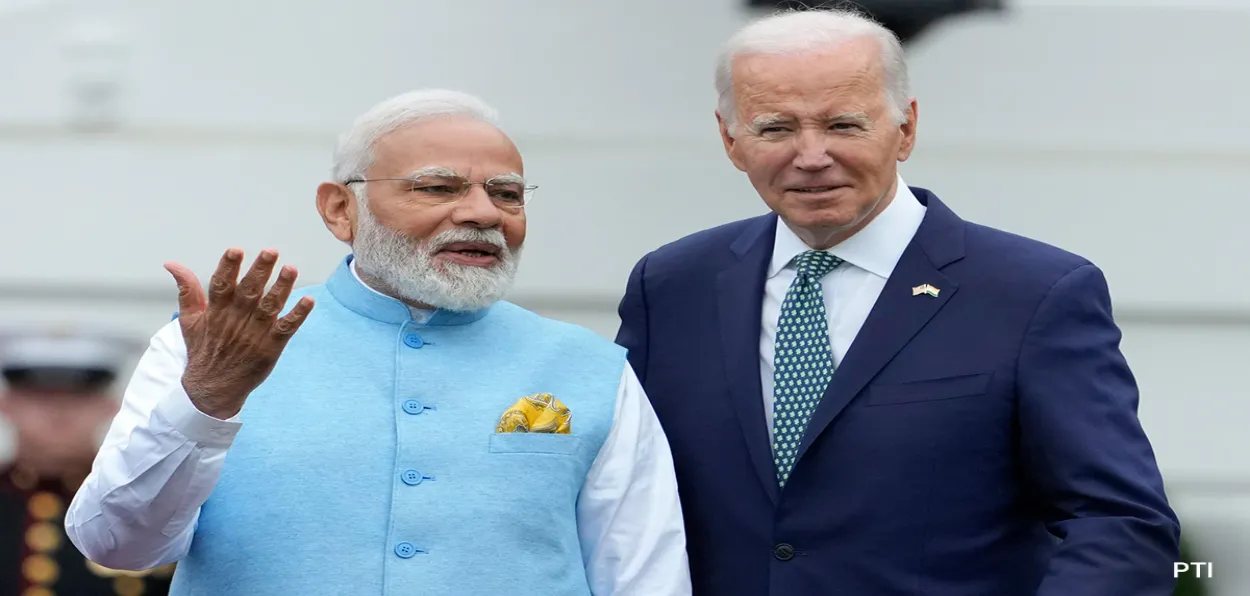
Sushma Ramachandran
Expectedly, Prime Minister Narendra Modi’s visit to the U.S. was a breakthrough in the otherwise volatile relationship between the two countries. However, its outcome has exceeded all expectations. The India-U.S. relationship has been elevated to an unprecedented level. The positive narrative began with the nature of the trip, with a state visit rolled out for only the third Indian leader since Independence. It indicated a serious effort towards wooing India, the largest democracy and fastest-growing economy in the world.
Though it is abundantly clear the two countries will never be in a formal alliance, it is equally evident that they are finally becoming firm strategic and business partners. On the strategic front, many significant deals were signed, including the pathbreaking transfer of technology for the joint manufacture of jet engines within this country. On the business front, many longstanding irritants needed for improving trade and economic ties got removed with compromises assiduously being made on both sides.
Much has been said already about the strategic aspect of the new partnership ranging from drone purchases and jet engine production to collaboration in space missions. The ties have deepened even further on the economic and trade front with technology becoming an additional critical layer along with traditional issues of tariffs, intellectual property, and movement of skilled professionals. The big-ticket announcement was a partnership in semiconductors as several leading chip manufacturers are now prepared to invest in India ensuring it becomes part of the global supply chain in the long run.
Collaboration in next-generation telecom technologies such as Open Radio Access Network (ORAN) also indicates that future developments in 6G could match or possibly even surpass China.
Finally, the cooperation being envisaged in the final technological frontier, Artificial Intelligence (AI), could ensure that ticklish regulatory issues may be smoothly resolved by the two countries and also carry weight in the international hi-tech community.
This kind of collaboration in areas of high technology makes eminent sense since the U.S. has physical and financial infrastructure while India has a huge pool of highly skilled manpower in the same key segments. The fact that persons of Indian origin are heading much of Big Tech sends a signal that tapping this rich human resource is the right way to go. Much credit must be given to the Modi government for forging ahead with this enhanced relationship, but the role of the Indian diaspora should not be downplayed.
Persons of Indian origin are in key posts of the Biden administration while the American tech eco-system is populated heavily with our countrymen. Many are founders of tech firms that dominate Silicon Valley. Their presence in critical roles in the U.S. government and corporate sector is a subtle nudge towards a deeper partnership with India.
Having said this, it must be recognized that the tipping point for bringing Indian and U.S. strategic interests on the same page has been the China factor. Both countries need a viable counterpoint to the economic supremacy of the Asian giant. As far as India is concerned, the increasing border skirmishes have not only motivated the development of greater infrastructure over its vast northern expanses, it has increased uneasiness over the expansion of economic ties with that country. For the U.S., the increasing fractiousness with its biggest trading partner over the past few years led to Trump’s denunciation of that country’s economic policies. The situation has worsened during the Biden era with the latest visit of Secretary of State Anthony Blinken failing to smooth over troubled waters. China may not be the only factor bringing the two countries together but it is an unsaid element in the newfound mutual warmth.
Yet it cannot be forgotten that India- U.S. economic ties in the past have bristled with differences. Both sides brushed these aside with surprising ease and managed to roll back punitive tariffs raised during the Trump era. To add to the bonhomie, six longstanding World Trade Organisation (WTO) disputes were withdrawn in one stroke. An irritant for Indian professionals on renewal of work visas has also been ironed out.
To be realistic, the road ahead for the enhanced partnership between the two countries will not be easy. There will continue to be vast divergences in views especially in the tricky area of market access where both countries are looking to raise exports and investments. The Biden administration will continue to seek lowering of tariffs to enable more products from that country to be sold here. It is the lure of the huge Indian marketplace that is one of the most attractive features for American firms investing in this country. There is no doubt that the Modi government will have to try and contain its tendency to be protectionist in terms of raising tariff barriers.
As it is, the U.S. is one of the few major trading partners with whom this country has a trade surplus. Reducing duties on selected goods will have a positive fall-out of raising the level of bilateral trade in goods which is still far below its potential at 128 billion dollars. At this level, India is still only the eighth largest trading partner of the U.S. and it needs to move much higher in this ranking.
ALSO READ: MWL Chief Al-Issa says no Constitution bars Muslims from performing prayers
These are issues that are likely to be resolved much more easily now that there is strong political will to keep India-U.S. ties on an even keel. This drive from the top will have to continue invariably if the new strategic and economic partnership between the two countries is to be maintained in the long run.
